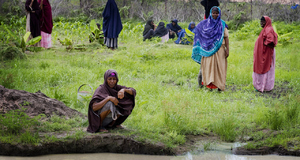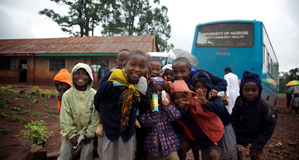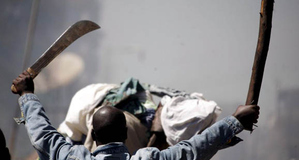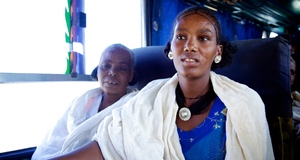Featured Article:Crime and Development in Kenya: Emerging Trends and the Transnational Implications of Political, Economic, and Social Instability
By
2010, Vol. 2 No. 09 | pg. 2/2 | « Weapons are also transported into Kenya and used for a variety of unlawful and dangerous means (RSO, personal statement, 2010). These weapons play a significant role in transnational crime as well as common street disorder in major cities. Since guns are not manufactured in Kenya, it is only logical to believe that the weapons enter the country in ways that are a danger to global security. According to the Small Arms Survey of 2001, “90 – 95 percent of households in northern Kenya are armed [with firearms] (Hugenberg et al, 2007). The Ibrahim Index, which rates countries on security issues, conducted a survey in 2008 regarding access to weapons, giving Kenya the highest rating in East Africa (UNODC, 2009). For such a significant percentage of gun-owners in a country where legal firearm possession is nearly impossible, it shows that Kenya’s border system is ineffective and that trafficking poses a significant threat to its safety and security. Crime is no longer as easily traceable and concretely defined as it once was. With advancements in technology over the last several decades, many developing nations, including Kenya, have seen the emergence of technological crime. Since the judicial system often works as a reactive mechanism, the juvenility of cyber offenses has put Kenya in a very difficult situation. There are minimal personnel within the Kenyan Police Force who possess any computer training and cyber legislation is just starting to take effect. Computer related crime can play an unfortunate role in society, and in Kenya, pertains mainly to money laundering and fraud (Omani, personal statement, 2010). With such an abundance of Internet cafés and advanced cellular telephones, these criminal offenses can take place nearly anywhere throughout the country. A fiber optic network was recently installed underneath the Indian Ocean and, beginning in 2009, started giving Kenyans access to very fast connectivity with the rest of the world. Security experts from the United States Embassy in Nairobi believe that the installation can be both great and terrible at the same time (RSO, personal statement, 2010). Kenya is beginning to play a role in global politics and business, meaning that access to technology by criminals can be increasingly detrimental to the sustainability and development of the country. To deal with the Kenyan Government’s lack of expertise in the field of technology, the United States built a Computer Forensic Lab in Nairobi, giving Kenyan Police the capability to search computer hard drives and better handle cases involving modern technology. Further advancements in connectivity over the next several years will likely have a profound effect on Kenya’s economy and society, giving the Government of Kenya the increasingly difficult task of keeping crime rates low.The Way Forward: Conquering Crime and Fostering Development in KenyaThe crime situation in Kenya is not unique within itself -- many of the problems that face Kenya on a criminological and developmental level are, for the most part, identical to those facing the surrounding countries in East Africa. Kenya has the atypical advantage of having a relatively stable government and such strong support from the international community. It is simply impossible for a nation to prosper [economically, politically, and socially] without proper safety and security (UNODC, 2009). There are no indications that crime levels will decrease over the years to come. Increased globalization gives Kenyans greater access to goods and services offered worldwide – whether positive or negative. Large-scale organized crime and terrorism operate on a transnational level, putting the burden on Kenya, as well as the international community, to gain a grasp on the situation. The fight against crime cannot be fought alone and fortunately, many countries [including the United States] are placing substantial resources within the borders of Kenya. Stability within Kenya has the potential to create an example for surrounding African nations. While the figures of crime facing Kenya are still some of the worst in East Africa, there is still considerable potential for a stable economy, government, and successful police force. First, the ratio of police to citizens needs to improve drastically. It is extremely unlikely for such a low number of police to actually make a significant difference in Kenya’s security. In addition to hiring more police officers, the salary and living conditions need to improve. Low pay and a lack of public respect breeds a sizeable amount of corruption, which puts a severe damper on the economy. Until the relationship between the police and Kenyan people improves, it is unlikely for crime levels to make any major statistical decline. Furthermore, the court system in Kenya needs a reorganization and overhaul because the utilization of police prosecutors has proven itself to be ineffective and outdated. More emphasis needs to be placed on the public sector of law, which includes an increase in training for judges and prosecutors. The approach to crime and security needs to be universal and include all regions of Kenya (UNODC, 2009) because ignoring areas and placing less emphasis on certain borders is a cause for disaster. Border security is an issue that faces many countries in the world and there is no reason why Kenya should lower its emphasis at such a critical time in global relations. Moving forward, it is important for Kenya to properly highlight its commitment to security as a nation and as a partner in the international fight against crime and terrorism. The budget for fiscal year 2011 outlined an increase of 2.2 billion shillings (roughly 29 million USD) for security purposes. This is a decent start to emphasizing crime control; however, the country of Kenya needs to always remember the tragedies and downfalls of its past and work together with the rest of the world in hopes of a more peaceful and less crime-ridden future. ReferencesAbzein, A. (2010). Interview with Alawy Abzein. Mombasa, Kenya. Anonymous. (2010). Kibera Slum Interview. Nairobi, Kenya. Barkan, J. D. (2004). Kenya After Moi. Foreign Affairs, 83 (1),12. BBC. (2002). The Threat from Portable Missiles, BBC Africa (29 November 2002 ed.). BBC. (2010). Somali Islamists al-Shabab 'join al-Qaeda fight'. Mogadishu, Somalia. Bowman, R. (2010). Interview with Resident Legal Advisor. Nairobi, Kenya. CIA World Fact Book. (2010). from https://www.cia.gov/library/publications/the-world factbook/fields/2060.html Florian Hugenberg, W. O. A., Angela Mwita. (2007). Firearm Injuries in Nairobi, Kenya: Who Pays the Price? Journal of Public Health Policy, 28, 10. Ischebeck-Baum, F. (2010). Maritime Piracy in East Africa. Nairobi, Kenya. Kenya, Transparency International (2008). The Kenya Bribery Index. Nairobi, Kenya. Legal Attache. (2010). Interview with Federal Bureau of Investigation at the U.S. Embassy. Nairobi, Kenya. Maina, E., Oboka, Wycliffe, Majong'o, Julius. (2004). History and Government (3 ed.). Nairobi: East African Educational Publishers Ltd. McDermott, T. (2002). Hints Ahead of Kenya Attack. Jerusalem: CBS News. Mukinda, F. (2010, 21/5/2010). New Pay for Kenya Police on the Way. The Daily Nation. Ndegwa, A. (2009, 19 November 2009). Kenya Leads Corruption Perception Index. The Standard. Nairobi, Kenya. Omani, T. (2010). Interview with Assistant Commissioner of Police. Nairobi. Onyango, N. (2010). A brief overview of the tourism sector in Kenya, from http://www.pwc.com/ke/en/industries/tourism.html Organised Crime and Trafficking in Eastern Africa. (2009). Nairobi, Kenya: United Nations Office on Drugs and Crime. RSO (2010). Interview With Regional Security Office at U.S. Embassy. Nairobi, Kenya Stavrou, A. (2002). Crime in Nairobi. Nairobi, Kenya: United Nations Habitat. Suggested Reading from Inquiries Journal
Inquiries Journal provides undergraduate and graduate students around the world a platform for the wide dissemination of academic work over a range of core disciplines. Representing the work of students from hundreds of institutions around the globe, Inquiries Journal's large database of academic articles is completely free. Learn more | Blog | Submit Latest in International Affairs |


















